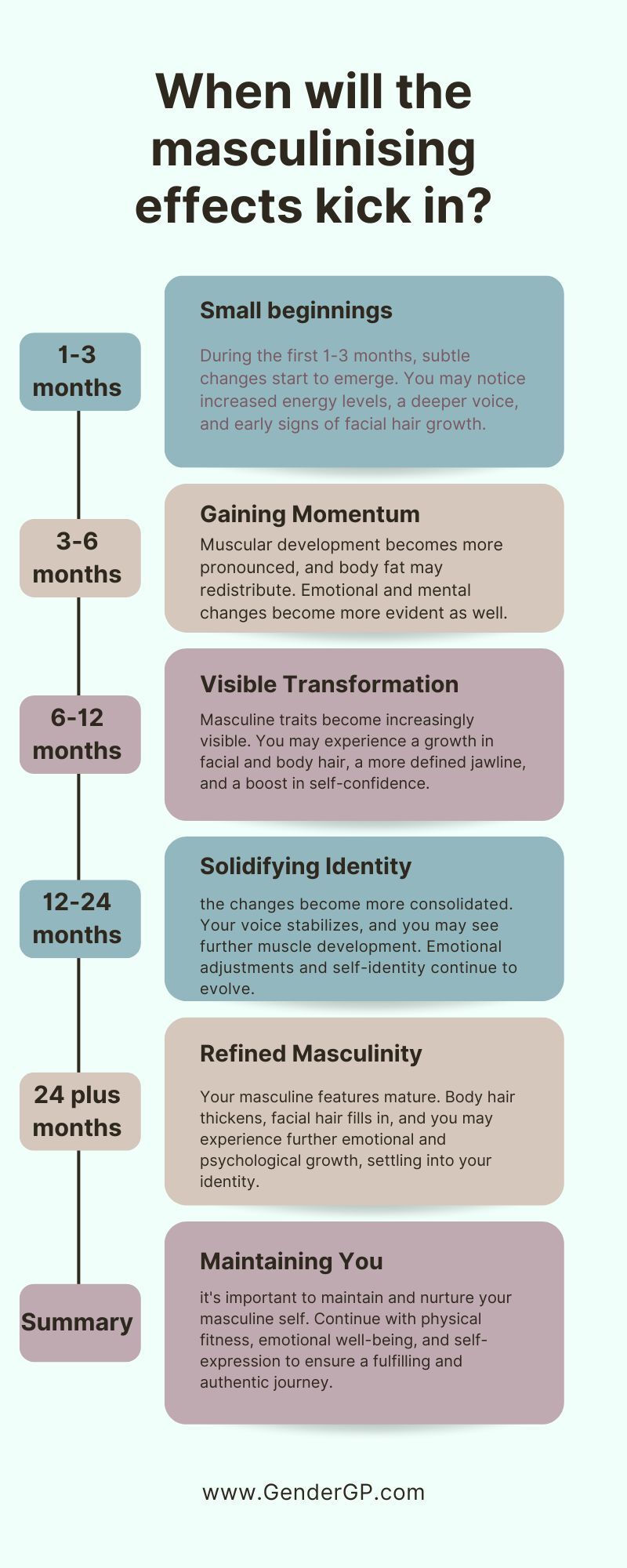Masculinisation Hormone Therapy An overview
Introduction
Masculinisation hormone therapy marks a significant milestone in the transition journey for many transgender men and transmasculine individuals. It’s a process that involves more than just physical transformation; it’s a deeply personal and empowering path toward aligning one’s body with their gender identity.
Understanding Masculinisation Hormone Therapy
This form of hormone therapy typically involves administering testosterone to induce physical changes that align with male characteristics. Additionally, for some individuals, estrogen blockers are also used to suppress the effects of estrogen, although testosterone alone is often sufficient in suppressing estrogen levels.
Hormones Used in Masculinisation
- Testosterone: The primary hormone for developing male secondary sexual characteristics. It can be administered via injections, patches, gels, or oral medications.
- Estrogen Blockers: Although not always necessary, these medications can be used to reduce the effects of estrogen, complementing the effects of testosterone, especially in cases where testosterone alone does not fully suppress estrogen production.
| Timeframe | Expected Changes |
|---|---|
| 1-3 Months | – Facial/body hair begins to grow. – Muscle mass starts to increase. – Skin becomes oilier. – Voice may start to deepen. |
| 3-6 Months | – Continued increase in muscle mass. – Further growth of facial/body hair. – Fat redistribution begins. – Voice deepening becomes more noticeable. |
| 6-12 Months | – Significant facial/body hair growth. – More pronounced muscle mass and strength. – Fat redistribution more evident. – Voice deepening completes. – Possible hairline changes. |
| 12-24 Months | – Stabilisation of physical changes – Finalising of fat redistribution. – Further development of masculine physical traits. |
| 24+ Months | – Maintenance of changes. – Continued masculinisation depending on ongoing therapy and individual factors. |
The Physical Changes
Masculinisation hormone therapy leads to various changes, which include but are not limited to:
- Facial and Body Hair Growth: One of the first noticeable changes is the increase in facial and body hair.
- Voice Deepening: Testosterone usually causes a deepening of the voice within a few months.
- Increased Muscle Mass and Body Fat Redistribution: There’s often an increase in muscle mass and a shift in body fat distribution to a more masculine pattern.
- Menstrual and Reproductive Changes: Testosterone therapy typically leads to the cessation of menstrual periods and may affect reproductive health.

Emotional and Psychological Impact
The benefits of masculinisation hormone therapy extend beyond physical changes. Many individuals experience a significant boost in self-esteem and mental health, as the therapy helps bring their physical appearance in line with their gender identity.
Considerations and Risks
- Medical Supervision: Hormone therapy should be undertaken under the guidance of a healthcare provider experienced in transgender health.
- Potential Side Effects: Testosterone therapy can have side effects such as acne, changes in lipid profiles, and increased red blood cell count. The use of any medication carries its own risks and potential side effects, which should be monitored.
- Fertility Considerations: Both testosterone and estrogen blockers can impact fertility. Those considering future biological children may want to explore fertility preservation options.
- Emotional Wellbeing: Mental health support is crucial during this journey, as hormonal changes can also impact emotional states and psychological wellbeing.
Conclusion
Masculinisation hormone therapy, often comprising testosterone and sometimes estrogen blockers, is a critical and life-affirming treatment for many transgender men and transmasculine individuals. It is a journey that encompasses physical, emotional, and psychological transformations. As the field of transgender healthcare continues to evolve, so does the approach to hormone therapy, ensuring more effective and personalised treatments for those embarking on this empowering path.
Related Articles
Expected Timeframes for Masculinisation During Hormone Therapy
Masculinisation hormone therapy is a cornerstone for many transgender men and transmasculine individuals in their transition journey. It involves administering testosterone, which brings about physical changes aligned with one’s gender identity. ...Feminisation Hormone Therapy An Overview
Introduction Feminisation hormone therapy is a cornerstone in the journey of transgender women and transfeminine individuals. It involves the use of hormones to induce physical changes that align with one’s gender identity. This transformative ...Skeletal Growth and Masculinisation
The effects of masculinisation through hormone therapy, particularly testosterone, on the skeleton can vary depending on several factors, including age and the timing of treatment in relation to the closure of growth plates (epiphyseal plates) in the ...Exploring Your Blood Testing Options for Hormone Therapy
Maintaining optimal hormone levels is essential for individuals undergoing hormone therapy, whether it's for gender transition, hormone replacement therapy, or other medical reasons. Regular blood tests play a crucial role in monitoring hormone ...Hormone Therapy for Androgyny or Non-Binary Alignment
Introduction In the diverse spectrum of gender identities, many individuals seek a physical appearance that is neither exclusively masculine nor feminine but rather androgynous. Hormone therapy for achieving an androgynous look is a nuanced and ...